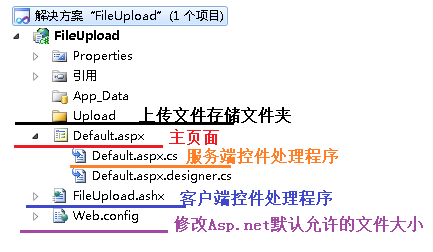【ASP.NET】文件上传与时间戳的获取
与ASP.NET其它所有控件一样,文件上传的实现同样有两种方式,一种是用服务端控件,另一种是利用客户端表单+.ashx的方式,当然,用Ajax完成文件上传也行,原理与客户端表单+.ashx的方式类似,只是传统的jQuery或javascript不支持Ajax提交文件,因此在前端可能你要借助Uploadify等控件才行。
如下图所示:
用两个形式,实现一个基本的pdf文件上传系统,当然这个文件上传系统还并不那么完善。实际上,文件上传系统还要进一步加工,考虑到大文件如果分割的情况,不要一次性将几M,十几M,几十M的东西往服务器那里扔。
解决方案目录结构如下:
由于Asp.net默认规定的上传文件大小仅有4M,因此,做这个系统你必须先在Web.Config修改一些东西,否则,上传大于4M的东西,解决方案会报错,直接找不到页面的。
具体是在system.web这一节加上如下语句:
<httpRuntime maxRequestLength="40960" executionTimeout="6000"/>
修改最大的上传大小为40M,处理一个文件最大时间为6s。
这样一定提高文件的上限。根据需要还可以进一步修改,当然上传更大的文件,你应该考虑使用一个文件上传插件,将大文件分割成一块又一块上传,实现断点上传等等。
毕竟,用户要上传一个30M的文件,将会在服务端中申请30M的内存去处理这个东西的,一些小型服务器吃不消。
在主页面Default.aspx的布置很简单:
<%@ Page Language="C#" AutoEventWireup="true" CodeBehind="Default.aspx.cs" Inherits="FileUpload._Default" %>
<!DOCTYPE html PUBLIC "-//W3C//DTD XHTML 1.0 Transitional//EN" "http://www.w3.org/TR/xhtml1/DTD/xhtml1-transitional.dtd">
<html xmlns="http://www.w3.org/1999/xhtml">
<head runat="server">
<title></title>
</head>
<body>
ASP.NET服务端控件的形式:
<form id="form1" runat="server">
<asp:FileUpload runat="server" ID="FileUpload1" />
<asp:Button runat="server" ID="Button1" OnClick="Button1_Click" Text="上传" />
</form>
客户端控件的形式:
<form action="FileUpload.ashx" method="post" enctype="multipart/form-data">
<input type="file" name="file" />
<input type="submit" value="上传" />
</form>
</body>
</html>
一个服务端表单、一个客户端表单,实际上在运用的时候,只要用其中一个就好。需要注意的是,客户端表单需要提交文件,因此除了基本的action属性,method一定要使用post,同时设置一个enctype="multipart/form-data"。
服务端表单,则直接使用ASP.NET封装好的FileUpload控件。需要注意的是,所有ASP.NET服务端控件都必须加上runat="server"。
先说对服务端控件搞上来的文件处理的Default.aspx.cs:
1、文件上传到解决方案根目录下的Upload文件夹之中。根目录可以通过Server.MapPath("~/")来获取。
2、此处服务端的文件名组织,写成原文件名+下划线+时间戳的形式,实际运用中还仅仅用时间戳、随机数来存这个文件,其它与这个文件相关信息存到数据库中,这样给用户下载的url可以简单很多,当然如果不提供下载、不打算入库,就还可以在文件名中带上用户id直接的,文件名请根据实际运用需要来组织。
using System;
using System.Collections.Generic;
using System.Linq;
using System.Web;
using System.Web.UI;
using System.Web.UI.WebControls;
namespace FileUpload
{
public partial class _Default : System.Web.UI.Page
{
/// <summary>
/// 获取时间戳
/// </summary>
public static string GetTimeStamp()
{
TimeSpan ts = DateTime.UtcNow - new DateTime(1970, 1, 1, 0, 0, 0, 0);
return Convert.ToInt64(ts.TotalSeconds).ToString();
}
protected void Page_Load(object sender, EventArgs e)
{
if (Session["info"] != null)//处理FileUpload.ashx传过来的信息
{
Response.Write(Session["info"]);
Session.Remove("info");//用完就销毁,减轻服务器的负担,相当于jsp的request容器
}
}
protected void Button1_Click(object sender, EventArgs e)
{
if (FileUpload1.HasFile)
{
string fileName = FileUpload1.FileName.Substring(0, FileUpload1.FileName.LastIndexOf("."));//文件名
string suffix = FileUpload1.FileName.Substring(FileUpload1.FileName.LastIndexOf(".")).ToLower();//后缀名
if (suffix.Equals(".pdf"))
{
FileUpload1.PostedFile.SaveAs(Server.MapPath("~/") + "./Upload/" + fileName + "_" + GetTimeStamp() + suffix);
Response.Write("上传成功!");
}
else
{
Response.Write("请上传pdf文件!");
}
}
else
{
Response.Write("请选择文件!");
}
}
}
}
而表单的处理FileUpload.ashx与Default.aspx.cs类似,需要注意的是:
1、上传的文件,可以通过HttpPostedFile file = context.Request.Files["file"];来获取,通过file.ContentLength > 0来判断其是否有文件上传。
2、需要注意到的还是.ashx中编程与.aspx.cs一些不同的地方,例如Session的使用需要自己调用接口。Respond与Request不能直接使用,需要用到context。Server同样不能直接使用,需要通过HttpContext.Current.Server来使用。
using System;
using System.Collections.Generic;
using System.Linq;
using System.Web;
using System.Web.SessionState;//要在ashx文件中使用Session就必须加这个
namespace FileUpload
{
/// <summary>
/// FileUpload 的摘要说明
/// </summary>
public class FileUpload : IHttpHandler, IRequiresSessionState//要在ashx文件中使用session就必须调用这个接口
{
/// <summary>
/// 获取时间戳
/// </summary>
public static string GetTimeStamp()
{
TimeSpan ts = DateTime.UtcNow - new DateTime(1970, 1, 1, 0, 0, 0, 0);
return Convert.ToInt64(ts.TotalSeconds).ToString();
}
public void ProcessRequest(HttpContext context)
{
context.Response.ContentType = "text/plain";
HttpPostedFile file = context.Request.Files["file"];
if (file.ContentLength > 0)
{
string fileName = file.FileName.Substring(0, file.FileName.LastIndexOf("."));
string suffix = file.FileName.Substring(file.FileName.LastIndexOf(".")).ToLower();
if (suffix.Equals(".pdf"))
{
file.SaveAs(HttpContext.Current.Server.MapPath("~/") + "./Upload/" + fileName + "_" + GetTimeStamp() + suffix);
context.Session["info"] = "上传成功!";
}
else
{
context.Session["info"] = "请上传pdf文件!";
}
}
else
{
context.Session["info"] = "请选择文件!";
}
context.Response.Redirect("Default.aspx");
}
public bool IsReusable
{
get
{
return false;
}
}
}
}


